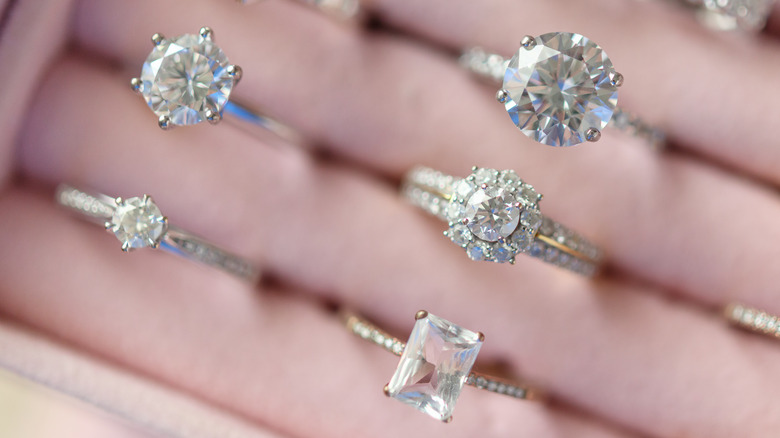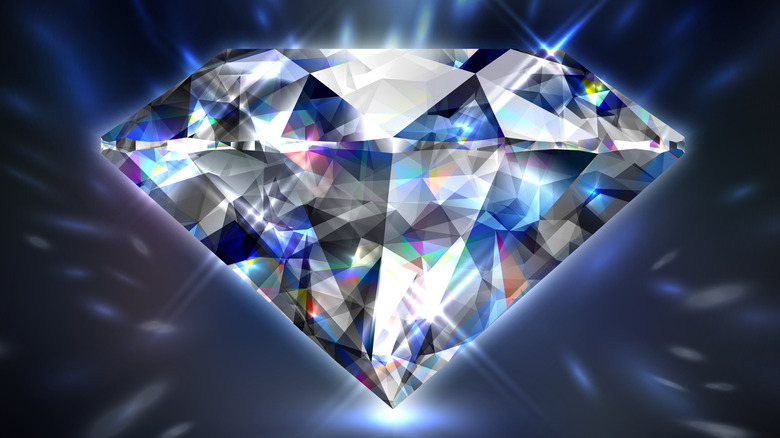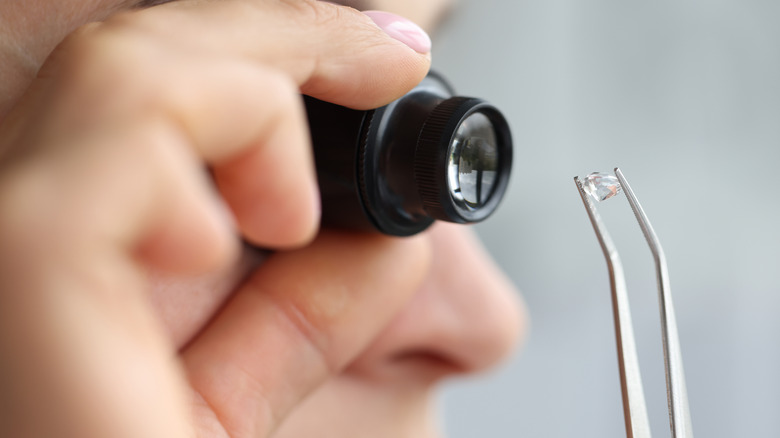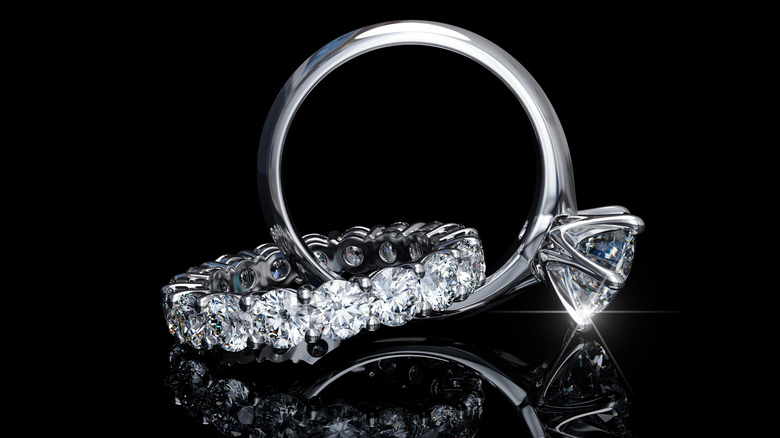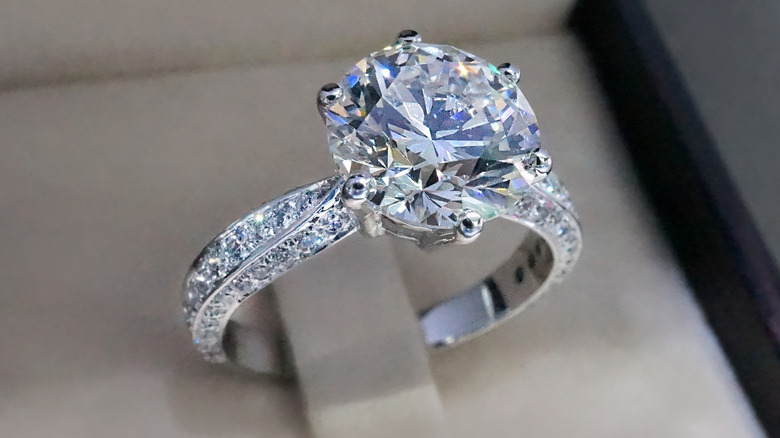Diamond Vs. Moissanite Engagement Rings: Which Is Right For You?
Correction 3/1/2023: This article has been updated to reflect that Charles & Colvard do not consider their stones to be colorless, as they use the industry standard color grading scale developed by the GIA.
When it comes to choosing an engagement ring, the creative possibilities keep expanding. With numerous engagement ring trends popping up, it can be even more challenging to find your perfect ring. Even so, diamond engagement rings continue to dominate the market. Thanks to a clever advertising campaign in the late 1940s, their popularity began to rise. Even in more recent times, diamonds are in 78% of engagement rings, according to Brilliance. People have been captivated by diamonds since the earliest specimens were discovered in India during the 4th century BCE. In years past, the rarity of these dazzling gems made them a possession of the elite and wealthy.
However, diamonds aren't everyone's preferred engagement gem. Other alternatives for engagement rings, such as sapphire engagement rings, have boasted a notable fan following of their own. But if a colorful stone isn't your cup of tea and you want to go beyond diamonds, consider a diamond lookalike: moissanite. Unlike earthbound diamonds, moissanite has astral origins. It was discovered in 1893 at the site of a meteorite impact in Arizona by Dr. Henri Moissan, a Nobel-winning chemist, who named the stone after himself. At first glance, Moissan thought it was a diamond, but tests revealed it was made of silicon carbide rather than carbon.
While diamonds and moissanites may look similar, the two stones have distinct differences. Depending on your priorities and preferences, this otherworldly choice could be your perfect alternative to traditional diamonds.
Moissanites excel in sparkle and colorful fire
Brilliance is a gemology term that describes the way a stone sparkles and bends light. Due to differences in their refraction, diamonds and moissanites each have a signature shine. If you're looking for a stone that provides a colorful light show, choose a moissanite ring. This stone has more fire than a diamond, meaning that you'll see more noticeable colors when you move it under light.
Moissanites also have more brilliance overall than diamonds. But while their remarkable fire may be a selling point for some people, others may find it overpowering. In contrast, diamonds' brilliance gives them plenty of sparkle. However, it's less colorful, with a twinkle that's more white or yellow and less rainbow-hued.
Diamonds come in natural and manmade varieties, while moissanites are all lab-created
While diamonds and moissanites occur in nature, only diamonds offer a choice of a natural or lab-grown stone. On the other hand, moissanite only has one option. "Moissanite is a naturally occurring mineral called silicon carbide, which is very rare and can't be found in nature large enough to be cut into even a one-carat gemstone," Don O'Connell, president and CEO of Charles & Colvard, told Brides.
In addition, it took 100 years after Dr. Moissan's discovery for researchers to figure out how to make moissanites in a lab. Each gem takes 2-3 months to create, notes the American Gem Society. Lab-grown diamonds have a comparable timetable: 6-10 weeks, per Walters & Hogsett Jewelers.
Since they are all lab-made, moissanites typically have the highest clarity with a minimum of imperfections. For diamonds, it's much more difficult to find a naturally-occurring stone that is as pristine.
Diamonds are colorless, and moissanites often have a hint of color
Even though diamonds come a variety of colors, colorless diamonds are more highly prized and expensive due to their rarity. These stones are graded from D-F by the Gemological Institute of America, while grades G-J are categorized as "near colorless," per Jewelry Notes.
In contrast, moissanites naturally have a hint of yellow, and the lab-made stones exhibit this trait. Some older versions of moissanites even have a slight touch of green or gray color. The tint is also more discernible in larger stones. Just like diamonds, moissanites' color is graded by letter. Moissanite-maker Charles & Colvard moissanite is available in two color grades: colorless (DEF) and near-colorless (GH).
However, the Diamond Pro disagrees with this assessment, asserting that because of the different materials (silicone carbide vs carbon), they can't be graded equally.
Moissanites are less expensive, but diamonds are more valuable
When it comes to price, moissanites are more affordable than diamonds. However, the two stones are a bit tricky to compare since moissanites are 15% lighter. In addition, diamonds are sold by carat weight, while moissanites are sold by size, per the Diamond Pro. However, when you look at two stones approximately the same size, a .5-carat diamond is twice as costly as a similarly sized moissanite. If you're interested in a bigger stone, the price difference becomes even more pronounced — and moissanites are substantially more budget-friendly.
On the other hand, if you consider your ring to be an investment piece, diamonds may be a better choice. While they cost more upfront, diamonds have a consistent value going back millennia. "Diamond is the most valuable, not only of precious stones, but of all things in this world," declared the ancient Roman Pliny during the first century AD, per GIA. So if the prestige of owning a bona fide diamond is your heart's desire, the higher cost may be worth it.
Love moissanite for its own sake, or consider your diamond options
Whatever type of engagement ring you choose, you want it to make you smile for years to come. While moissanites may look like diamonds, they are their own unique stone, not a diamond substitute. Fortunately, no matter which one you choose, both are hard-wearing stones. While diamonds are a 10 on the Mohs Scale of Hardness, moissanites are a 9.5, making them slightly harder than sapphires, notes Gema & Co.
So how to choose? If you're a diamond lover and are concerned about costs, consider a lab-grown diamond. Compared to naturally mined diamonds, they are 50-70% less expensive and don't have the ethical concerns associated with mined gems.
On the other hand, if you're a fan of extra sparkle and color, moissanite's unparalleled fire might clinch your decision. As an added bonus, with its lower price point, you could opt for a larger stone or simply keep the extra savings.
